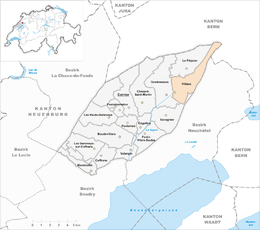Villiers (Neuchâtel)
| Villiers | ||
|---|---|---|
| Former municipality of Switzerland | ||
|
||
| Coordinates: 47°5′N 6°58′E / 47.083°N 6.967°ECoordinates: 47°5′N 6°58′E / 47.083°N 6.967°E | ||
| Country | Switzerland | |
| Canton | Neuchâtel | |
| District | Val-de-Ruz | |
| Area | ||
| • Total | 10.59 km2 (4.09 sq mi) | |
| Elevation | 760 m (2,490 ft) | |
| Population (December 2011) | ||
| • Total | 450 | |
| • Density | 42/km2 (110/sq mi) | |
| Postal code | 2057 | |
| SFOS number | 6486 | |
| Surrounded by | Dombresson, Enges, Le Pâquier, Lignières, Nods (BE), Saint-Imier (BE), Savagnier, Villeret (BE) | |
| Website | SFSO statistics |
|
Villiers is a former municipality in the district of Val-de-Ruz in the canton of Neuchâtel in Switzerland.
The municipalities of Boudevilliers, Cernier, Chézard-Saint-Martin, Coffrane, Dombresson, Engollon, Fenin-Vilars-Saules, Fontainemelon, Fontaines, Les Geneveys-sur-Coffrane, Les Hauts-Geneveys, Montmollin, Le Pâquier, Savagnier and Villiers merged on 1 January 2013 into the new municipality of Val-de-Ruz.
Villiers is first mentioned in 1191 as in Vilar. In 1308 it was mentioned as de Villier.
Villiers had an area, as of 2009[update], of 10.6 square kilometers (4.1 sq mi). Of this area, 4.7 km2 (1.8 sq mi) or 44.5% is used for agricultural purposes, while 5.61 km2 (2.17 sq mi) or 53.1% is forested. Of the rest of the land, 0.27 km2 (0.10 sq mi) or 2.6% is settled (buildings or roads) and 0.02 km2 (4.9 acres) or 0.2% is unproductive land.
Of the built up area, housing and buildings made up 1.5% and transportation infrastructure made up 0.9%. Out of the forested land, 49.4% of the total land area is heavily forested and 3.7% is covered with orchards or small clusters of trees. Of the agricultural land, 8.3% is used for growing crops and 17.1% is pastures and 18.8% is used for alpine pastures.
...
Wikipedia



